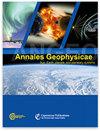Deep temporal convolutional networks for F10.7 radiation flux short-term forecasting
IF 1.9
4区 地球科学
Q3 ASTRONOMY & ASTROPHYSICS
引用次数: 0
Abstract
Abstract. F10.7, the solar flux at a wavelength of 10.7 cm (F10.7), is often used as an important parameter input in various space weather models and is also a key parameter for measuring the strength of solar activity levels. Therefore, it is valuable to study and forecast F10.7. In this paper, the temporal convolutional network (TCN) approach in deep learning is used to predict the daily value of F10.7. The F10.7 series from 1957 to 2019 are used. The data during 1957–1995 are adopted as the training dataset, the data during 1996–2008 (solar cycle 23) are adopted as the validation dataset, and the data during 2009–2019 (solar cycle 24) are adopted as the test dataset. The leave-one-out method is used to group the dataset for multiple validations. The prediction results for 1–3 d ahead during solar cycle 24 have a high correlation coefficient (R) of 0.98 and a root mean square error (RMSE) of only 5.04–5.18 sfu. The overall accuracy of the TCN forecasts is better than the autoregressive (AR) model (it only takes past values of the F10.7 index as inputs) and the results of the US Space Weather Prediction Center (SWPC) forecasts, especially for 2 and 3 d ahead. In addition, the TCN model is slightly better than other neural network models like the backpropagation (BP) neural network and long short-term memory (LSTM) network in terms of the solar radiation flux F10.7 forecast. The TCN model predicted F10.7 with a lower root mean square error, a higher correlation coefficient, and a better overall model prediction.用于 F10.7 辐射通量短期预报的深度时空卷积网络
摘要F10.7,即波长为 10.7 厘米(F10.7)的太阳通量,经常被用作各种空间天气模式的重要输入参数,也是测量太阳活动强度的关键参数。因此,研究和预测 F10.7 具有重要价值。本文采用深度学习中的时序卷积网络(TCN)方法来预测 F10.7 的日值。本文使用 1957 年至 2019 年的 F10.7 系列数据。1957-1995 年的数据作为训练数据集,1996-2008 年(太阳周期 23)的数据作为验证数据集,2009-2019 年(太阳周期 24)的数据作为测试数据集。采用 "留一弃一 "的方法对数据集进行分组,以进行多次验证。太阳周期 24 期间提前 1-3 d 的预测结果相关系数(R)高达 0.98,均方根误差(RMSE)仅为 5.04-5.18 sfu。TCN预报的整体准确性优于自回归(AR)模式(它只将过去的F10.7指数值作为输入)和美国空间天气预报中心(SWPC)的预报结果,尤其是在未来2天和3天。此外,在太阳辐射通量 F10.7 预报方面,TCN 模型略优于其他神经网络模型,如反向传播(BP)神经网络和长短期记忆(LSTM)网络。TCN 模型预测 F10.7 的均方根误差更小、相关系数更高,而且模型的整体预测效果更好。
本文章由计算机程序翻译,如有差异,请以英文原文为准。
求助全文
约1分钟内获得全文
求助全文
来源期刊

Annales Geophysicae
地学-地球科学综合
CiteScore
4.30
自引率
0.00%
发文量
42
审稿时长
2 months
期刊介绍:
Annales Geophysicae (ANGEO) is a not-for-profit international multi- and inter-disciplinary scientific open-access journal in the field of solar–terrestrial and planetary sciences. ANGEO publishes original articles and short communications (letters) on research of the Sun–Earth system, including the science of space weather, solar–terrestrial plasma physics, the Earth''s ionosphere and atmosphere, the magnetosphere, and the study of planets and planetary systems, the interaction between the different spheres of a planet, and the interaction across the planetary system. Topics range from space weathering, planetary magnetic field, and planetary interior and surface dynamics to the formation and evolution of planetary systems.
 求助内容:
求助内容: 应助结果提醒方式:
应助结果提醒方式:


